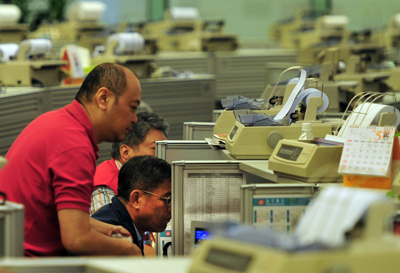Friday, 13 March 2015 12:50
 TOKYO: Asian shares put in a mixed performance across the region on Friday but were underpinned by gains on Wall Street, while the dollar resumed its recent rally after a downward blip on disappointing US retail sales data.
TOKYO: Asian shares put in a mixed performance across the region on Friday but were underpinned by gains on Wall Street, while the dollar resumed its recent rally after a downward blip on disappointing US retail sales data.
Financial spreadbetters predicted the US gains would give European bourses an early lift, with Britain’s FTSE 100 seen opening 12 points to 14 points higher, or as much as 0.2 percent, and France’s CAC 40 seen opening 15 to 16 points higher, or as much as 0.3 percent.
Germany’s DAX was expected to open 35 to 44 points higher, or as much as 0.4 percent, set for its ninth consecutive weekly gain, which would give it the longest winning streak since 1998.
The euro skidded about 0.5 percent against the greenback to $ 1.0576, but remained well above a 12-year trough of $ 1.0494 plumbed in the previous session.
“The short-term outlook stays negative in my view, thus I would expect the bears to eventually take control again and perhaps aim for another test at the $ 1.0500 key area,” Marshall Gittler, head of FX strategy at IronFX Global, said in a note to clients.
MSCI’s broadest index of Asia-Pacific shares outside Japan erased gains late in the session and was down about 0.2 percent, though it remained well off 7-week lows plumbed earlier in the week. It was on track for a weekly loss of more than 2 percent.
Japan’s Nikkei stock average rose 1.4 percent to a fresh 15-year closing high, marking its fifth straight winning week. The robust gains were partly due to a 13 percent surge in shares of industrial robot maker Fanuc Corp, which has a disproportionately high weighting in the Nikkei. A report said the company was considering raising dividends.
On Wall Street, US shares rallied on Thursday, but the S&P 500 was still on track to post its third consecutive weekly decline, hit by the prospect of higher US interest rates and the effect of the strong dollar on corporate earnings.
But the dollar pulled away from its recent multi-year highs on Thursday after US retail sales unexpectedly fell in February, a month marked by harsh weather. That tempered the outlook for first-quarter growth and gave investors reason to doubt that the Federal Reserve might hike interest rates as early as June.
However, many investors’ rate-hike bets remained intact after last week’s stronger-than-expected US payrolls report. The Fed’s policy-setting committee meets on March 17 and 18, and investors hope the meeting will yield further clues about the timing of the rate increase.
The dollar index edged higher to 99.570 after skidding 0.4 percent on Thursday, in its biggest one-day fall in a month. The index had earlier risen as far as 100.060, a high not seen since mid-April 2003, and was still on track to end the week up more than 1 percent.
Against its Japanese counterpart, the dollar rose about 0.2 percent on the day to 121.46 yen, moving back toward this week’s nearly eight-year high of 122.04.
In sharp contrast with the Fed, the European Central Bank launched a quantitative easing programme this week that sent yields on the debt of nearly all euro zone countries to record lows, and prompted investors to park their funds elsewhere.
“Euro zone debt may look a little overvalued,” said Masashi Murata, senior currency strategist at Brown Brothers Harriman in Tokyo. “They will of course remain well bid under ECB’s bond buying scheme, but their gains have been too rapid. The euro may thus hold in range in the short term, especially with dollar demand ebbing a little ahead of next week’s Federal Reserve meeting.”
Oil prices steadied after an overnight sell-off following estimates showing another big supply build at the delivery point for the US crude contract.
US crude edged up about 0.3 percent to $ 47.17 a barrel after plunging 2.3 percent in the previous session, while Brent edged slightly higher to $ 57.09 after shedding nearly 1 percent.
Copyright Reuters, 2015




























